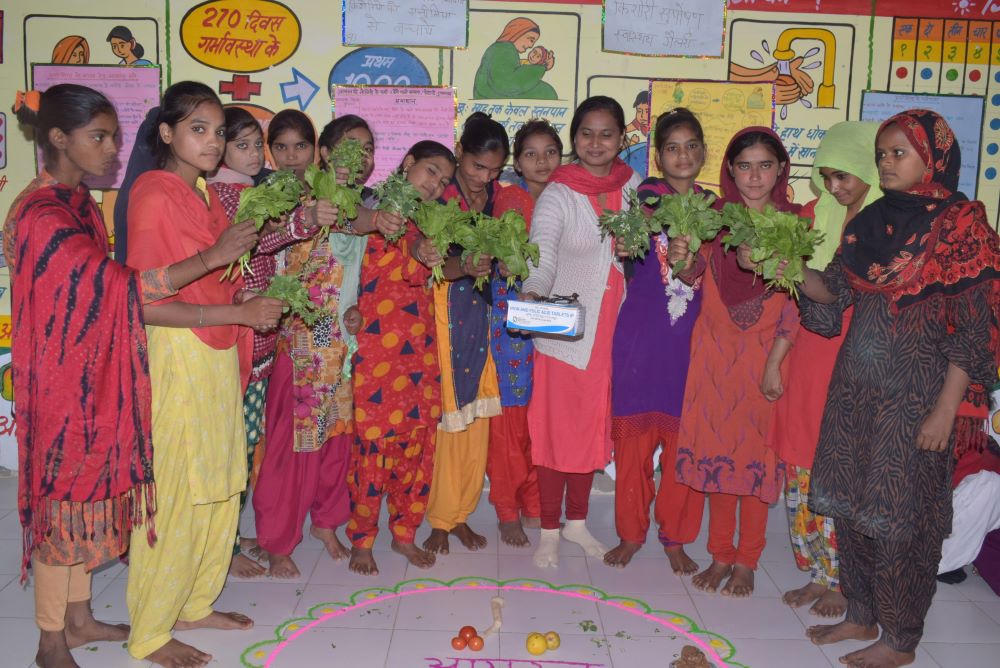Field Stories
Meet a health and wellness messenger providing peer support in India
March 20, 2025
WP_Term Object
(
[term_id] => 49
[name] => Field Stories
[slug] => all-field-stories
[term_group] => 0
[term_taxonomy_id] => 49
[taxonomy] => news-category
[description] => Discover the personal stories of people whose lives have been impacted by better nutrition, and those working tirelessly to deliver it.
[parent] => 0
[count] => 180
[filter] => raw
)
Leading by example: A health worker transforms minds and lives in rural India
In Niyamatpur, a village in the Moradabad district of Uttar Pradesh, the local Anganwadi, or health centre, is a bustling hub for adolescent girls who don't attend school. This is thanks to Mamta Rani, the neighbourhood Anganwadi worker (AWW) who has been running the centre for two years.
Posted on April 6, 2020


Uttar Pradesh, INDIA: In Niyamatpur, a village in the Moradabad district of Uttar Pradesh, the local Anganwadi, or health centre, is a bustling hub for adolescent girls who don’t attend school. This is thanks to Mamta Rani, the neighbourhood Anganwadi worker (AWW) who has been running the centre for two years.
The girls call her Mamta Didi, or sister. Every week, they visit the centre, where they receive their weekly iron and folic acid (IFA) supplement and essential health and nutrition information. Mamta answers their questions and helps them understand the importance of good nutrition.
Mamta and her fellow AWWs cater to nearly 8,700 people through five Anganwadi centres in the area. In 2017 Nutrition International organized workshops for nearly 7,400 teachers and local healthcare providers on weekly iron and folic acid supplementation (WIFAS) and the technical and operational aspects of the program, including outreach to out-of-school adolescent girls who do not receive the tablets at school.
Until then, AWWs had limited knowledge of the effects of anaemia and the role of iron and folic acid supplementation in its prevention. Realizing the impact that this could have on her community, Mamta was determined to reach out to all out-of-school girls in her village and register them to receive WIFAS at her centre.
This was not an easy task. Due to many myths and misconceptions surrounding the tablets, Mamta faced resistance from community members unwilling to allow their daughters to take them. Unfazed, she was determined to find a solution.
Mamta teamed up with the Gram Pradhan, or village head. Together, they began mobilizing communities and disproving myths around the IFA tablets. She made a concerted effort to transform her Anganwadi centre into a health information centre, lined with charts and interactive learning material provided by the department of health and Nutrition International.
Every Wednesday, girls come to the centre to receive their WIFAS. They often stay, sometimes using vegetables to create rangoli, a colourful folk art, on the floor. As they build their designs, Mamta watches and explains the nutritional value of each vegetable. If, for any reason, a girl is absent, Mamta will visit her at home and personally hand over her tablet.
Mamta’s centre has been able to reach most of the out-of-school girls in the village with IFA supplementation. The girls in Niyamatpur have benefitted from her years of hard work, seeing improved health and nutrition, as well as increased energy and productivity. They now act as anaemia warriors in their own communities. Mamta also provides support to fellow AWWs and has helped them roll out and strengthen their own WIFAS programs.
Her efforts have contributed to the Anaemia Mukt Bharat initiative, the Government of India’s campaign to tackle anaemia. In the national fight against adolescent anaemia, Mamta and her centre are a beacon of hope and a model for others across the country.